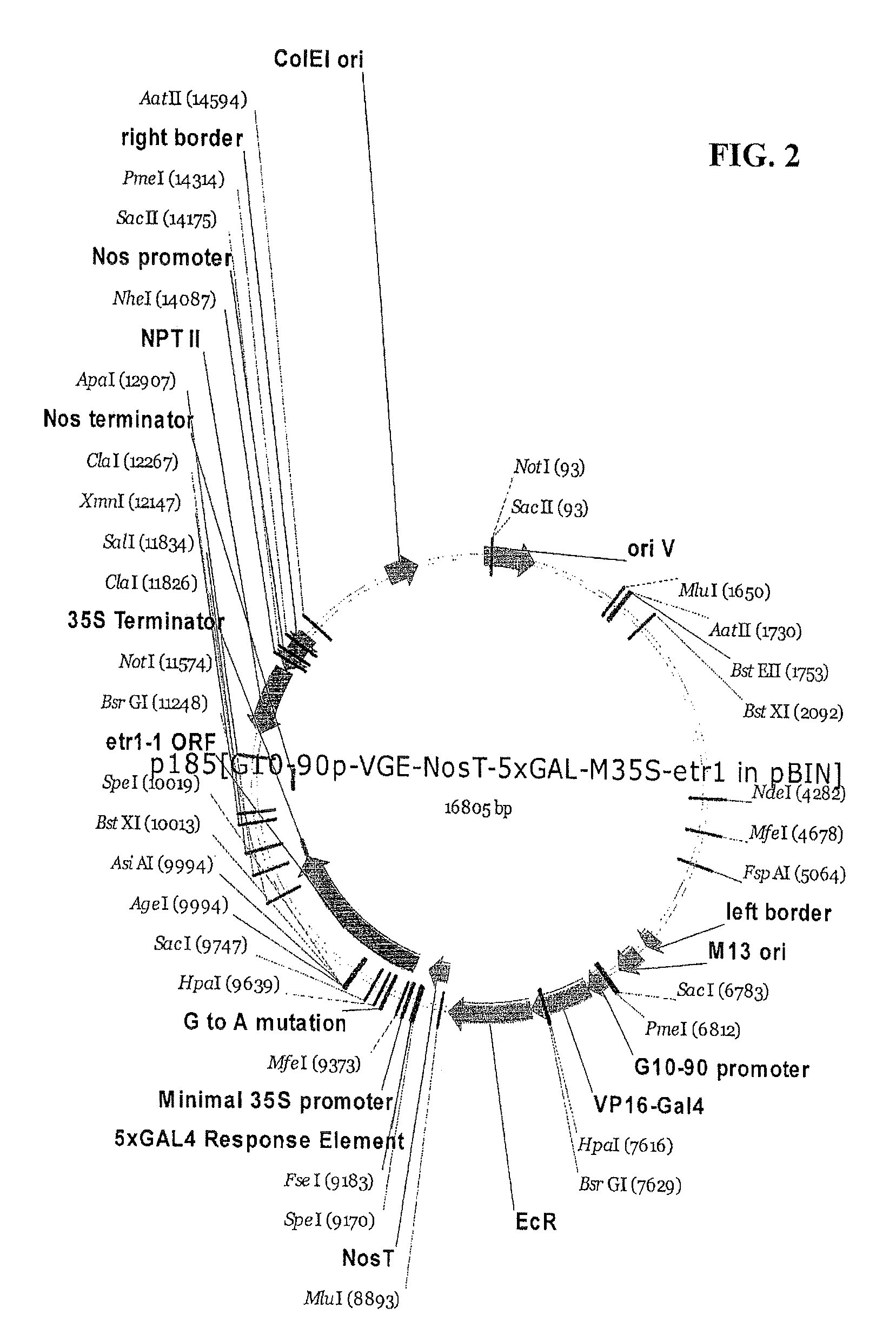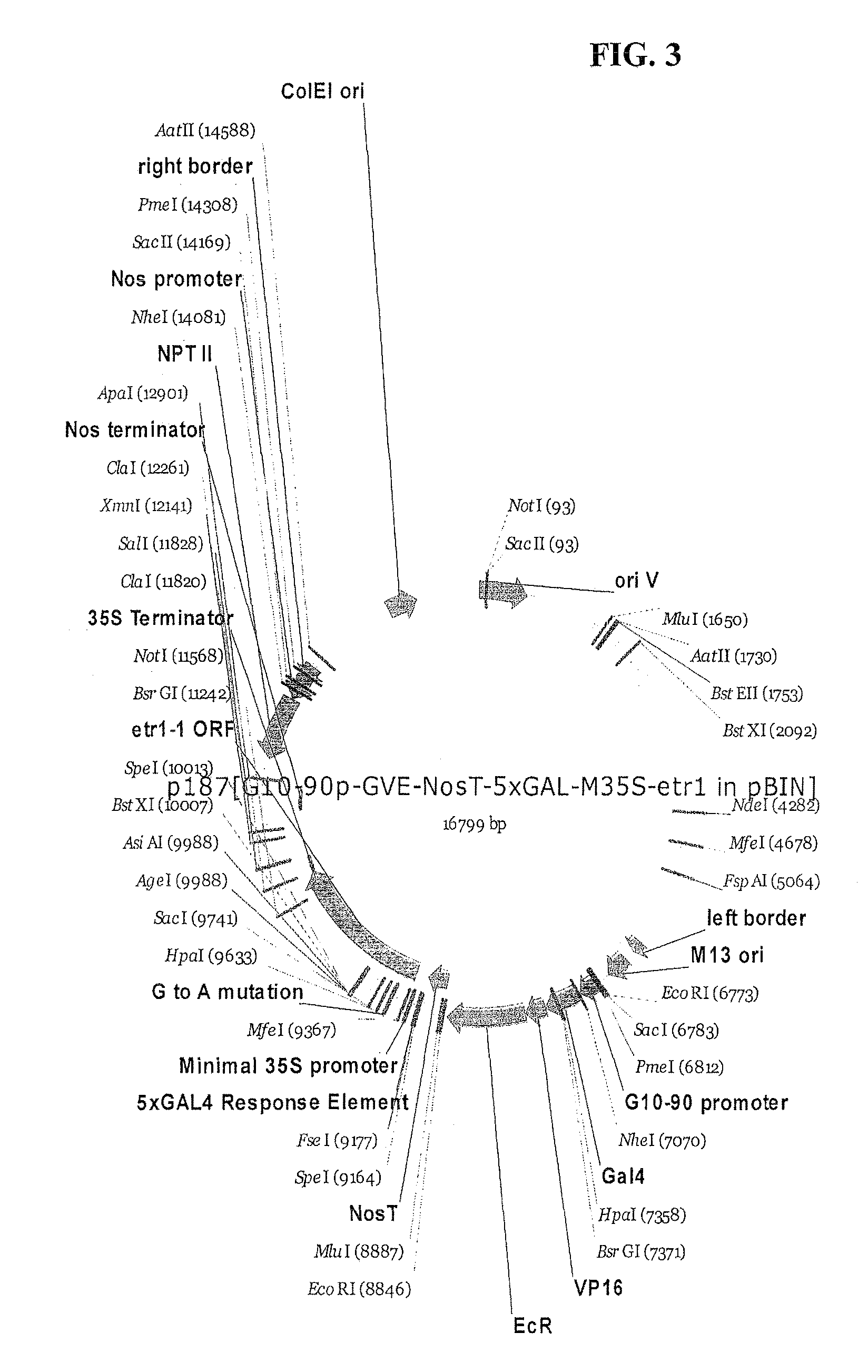Compositions and methods for the modification of physiological responses in plants
a technology of physiological responses and compositions, applied in the field of compositions and methods for the modification of physiological responses in plants, can solve the problems of increased ethylene insensitivity of plants, low induction level, toxic or volatile inducers, etc., and achieves tight gene expression regulation, reliable and safe control, and the effect of regulating ethylene sensitivity
- Summary
- Abstract
- Description
- Claims
- Application Information
AI Technical Summary
Benefits of technology
Problems solved by technology
Method used
Image
Examples
example 1
Plasmids
[0099]The gene cassette components include for the activation cassette: the G10-90 constitutive promoter (nucleotide 1 to 243 of SEQ ID NO: 1), the VP16 activation domain (nucleotide 249 to 529 of SEQ ID NO: 1), the GAL4 DNA binding domain (nucleotide 534 to 983 of SEQ ID NO: 1), and the T52V mutant ecdysone receptor ligand binding domain (nucleotide 990 to 1997 of SEQ ID NO: 1) associated with the NOS terminator sequence (nucleotide 2070 to 2364 of SEQ ID NO: 1) were individually cloned. Similarly, the target cassette components, including the inducible promoter which consists of five copies of the GAL4 response element (nucleotide 2391 to 2492 of SEQ ID NO: 1) and the minimal 35S promoter (nucleotide 2499 to 2554 of SEQ ID NO: 1), and the mutant etr1-1 gene (nucleotide 2557 to 4764 of SEQ ID NO: 1) and the 35S terminator sequence (4791 to 5001 of SEQ ID NO: 1) were individually cloned. SEQ ID NO: 1 is shown in FIG. 4.
[0100]These components were assembled in expression cass...
example 2
Production of Transgenic Tobacco Plants
[0121]Tobacco plants were transformed with the plasmids of Example 1 and were produced by standard Agrobacterium-mediated leaf disc transformation as described in Fisher and Guiltinan 1995 Plant Molecular Biology Reporter 13: 278-289. Plants were propagated on rooting medium containing kanamycin and then the introduction and inheritance of the gene expression system was confirmed by PCR as described below.
[0122]Single leaf from each plant maintained in a magenta box was collected by snap freezing in liquid nitrogen and stored frozen at −80° C. Leaf (50-100 mg) was then transferred to KONTES tube and ground with the KONTES disposable pestle using a drill for about 1 minute and then for a few second after adding lysis buffer. DNA was purified using the DNEASY mini kit (Qiagen). DNA was finally eluted in 100 μl.
[0123]Specific PCR primers were designed to amplify the 529 bp of VGE, the 495 bp of GVE, the 463 bp of the marker gene luciferase LUC, or...
example 3
Effect of Modulation of Ethylene Sensitivity on Tobacco Plant Growth
[0130]A triple response assay as described in Guzman and Ecker 1990 The Plant Cell, 2:513-523, modified as provided herein, was conducted to determine the effect of the modulation of ethylene sensitivity in the transformed tobacco plants of Example 2. From each transformed plant designated 185-1, 184-3, 185-8, 185-11, 187-7, 187-13, 187-17 and 187-21, two leaves from each plant were cut into small pieces. These pieces were plated onto MSS plates containing 100 ng / L kanamycin, with or without 10 μM inducer, i.e., 3,5 Dimethyl-benzoic acid N-(1-ethyl-2,2-dimethyl-propyl)-N′-(3S-hydroxymethyl-5-methyl-2,3-dihydro-benzo[1,4]dioxine-6-carbonyl)hydrazide. MSS plates without antibiotic or inducer were used as controls.
[0131]These plated plant tissues were grown at 25° C. with light in growth chambers to induce shoots. Shoots were transferred into fresh plates for about two weeks for continued growth at 25° C. Each callus w...
PUM
| Property | Measurement | Unit |
|---|---|---|
| concentration | aaaaa | aaaaa |
| length | aaaaa | aaaaa |
| population density | aaaaa | aaaaa |
Abstract
Description
Claims
Application Information
 Login to View More
Login to View More - R&D
- Intellectual Property
- Life Sciences
- Materials
- Tech Scout
- Unparalleled Data Quality
- Higher Quality Content
- 60% Fewer Hallucinations
Browse by: Latest US Patents, China's latest patents, Technical Efficacy Thesaurus, Application Domain, Technology Topic, Popular Technical Reports.
© 2025 PatSnap. All rights reserved.Legal|Privacy policy|Modern Slavery Act Transparency Statement|Sitemap|About US| Contact US: help@patsnap.com



